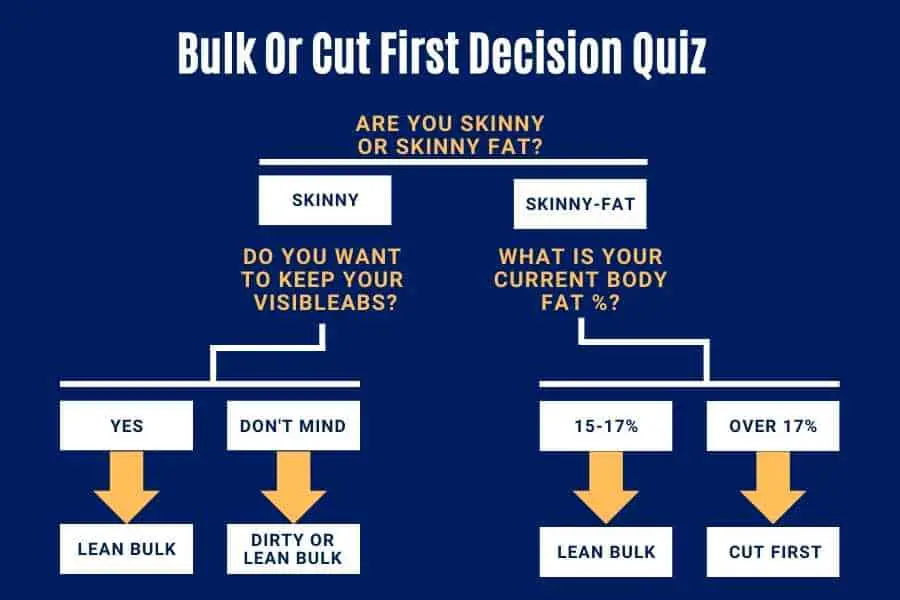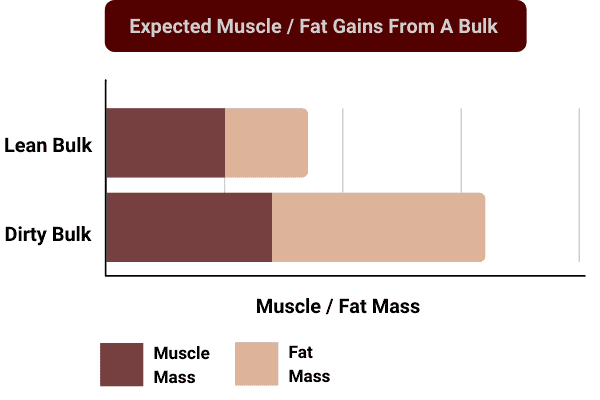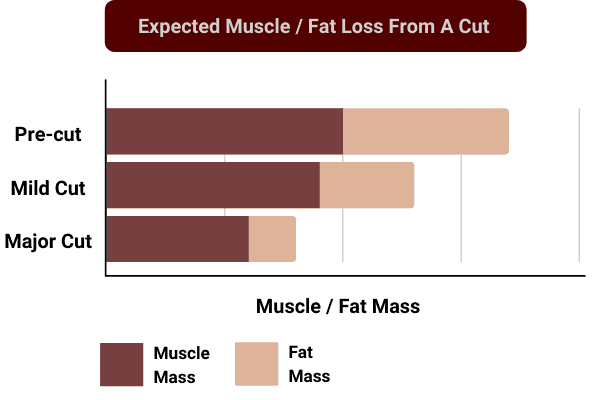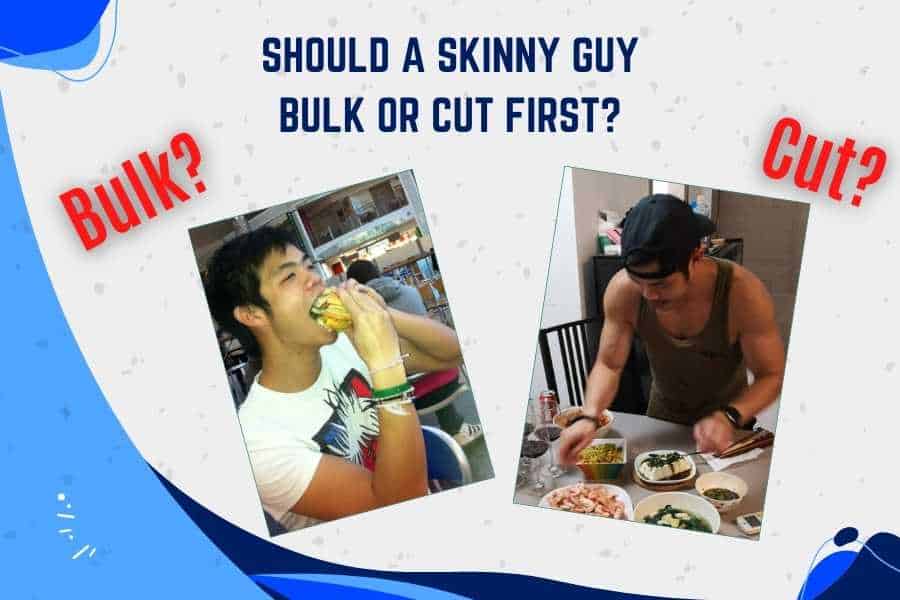As a skinny guy, the decision to bulk or cut first is essential and sets the tone for the rest of your body transformation. But it can be difficult for a beginner to make the right choice. This post will help you decide.
Skinny people should generally bulk before cutting. This is ideal for quickly gaining muscle mass and increasing strength. However, skinny-fat people may want to consider first going on a cut in order to lose excess body fat, and then start bulking after.
I’m an ex-skinny guy myself. I’ve been on more bulk-cut cycles than my hands can count. And my goal is to help you build a ripped muscular physique, revealing the definition you’ve always wanted.

Key Takeaways:
- Bulk first if you are scrawny-skinny (<15% body fat and little muscle).
- Choose between a bulk or cut if you are borderline skinny-fat (15-17)% body fat and little muscle).
- Cut first if you are skinny-fat (17-20% body fat and little muscle).
- Lean bulking is recommended for building muscle with minimal fat gain.
- Mild cuts are recommended to lose fat sustainably and preserve muscle mass.
Decision Quiz: Should Skinny Guys Bulk Or Cut First?
Identifying your current body type and your overall goal is key to making the right choice.
Questions to ask yourself when choosing between whether bulk or cut first:
- Are you scrawny or skinny-fat?
- Do you currently have visible abs that you would like to keep?
- Would you prefer a lean or bulky muscular look?
- Is maximizing strength important to you?
- How tolerant are you of the fat gains that inevitably come with muscle growth?
Here’s a chart to help you decide:

Additionally, you should always remember 3 general rules about bulking and cutting:
- Body fat is gained when you build muscle.
- Some muscle loss occurs when you lose fat.
- How much muscle and fat you gain or lose depends on the intensity of your calorie surplus/deficit.
Differences Between Scrawny-Skinny Vs Skinny-Fat
Skinny people have very little muscle mass and a low body fat percentage (typically less than 15%). In contrast, skinny-fat people also have very little muscle mass, but they also have a high body fat percentage (typically 15-20%).
The table below outlines the trait differences between each body type:
| Typical Traits | Scrawny-Skinny | Skinny-Fat |
|---|---|---|
| Body Fat Percentage | 10-15% | 15-25% |
| Noticeable Belly Fat | No | Yes |
| Muscular Definition | High | Low |
| Visible abs | Yes | No |
| Muscle Mass | Low | Low |
Note: for simplicity’s sake we’ll just use the term “skinny” to describe the scrawny-skinny type from here onwards.
The photo below shows the visible differences between each body type:

Here’s the recommended bulk-cut strategy for each type of skinny guy and why:
- Skinny. Go on a 3-6 month lean or dirty bulk first to build muscle and strength. After, cut for 2 months to lose excess fat.
- Borderline skinny-fat. Go on a 2-3 month lean bulk first to build muscle and strength. After, cut for 2 months to lose fat.
- Skinny-fat. Go on a 2-3 month cut first to lose excess fat. After, bulk for 3-6 months to build muscle and strength.
Regardless of which type you belong to, multiple bulk-cut cycles are often required to reach your final goal of building a muscular, well-defined, and ripped physique.
Next, I’ll share the main benefits and drawbacks of bulking and cutting. This helps you to understand why different types of body types are recommended to adopt different strategies.
Benefits & Drawbacks Of Bulking First

The main advantages and disadvantages of a bulk and why it can be good and bad:
| Advantage | Disadvantage |
|---|---|
| Builds muscle and strength when combined with heavy resistance training. | Fat gain is inevitable regardless of the bulking method (lean vs dirty) adopted. |
| Increasing muscle mass makes it easier to lose fat in the future. | Generally unhealthy for anyone who already has a high body fat percentage. |
| Calorie surplus provides more energy for workouts. | Gaining muscle is a slower process than losing fat. |
Advantages Explained:
- Build muscle and strength. Going on a bulk is the only way you can get noticeably bigger and stronger. Combine a bulking diet with these exercises for skinny guys to get bigger and stronger.
- Facillitating fat loss. Muscle is metabolically active tissue meaning it consumes calories even at rest. Building a solid base of lean mass, therefore, helps you to get ripped faster in the future.
- More energy for workouts. Bulking requires you to be in a calorie surplus. This gives you more energy to train hard (important for building muscle). Most people find this more enjoyable than training on an empty tank which is common during a cut.
Disadvantages Explained:
- Inevitable fat gain. Unfortunately, this is just how the body works. Gaining muscle goes hand in hand with storing fat (and vice versa). Fortunately, you can skew the different rates of muscle and fat gain by varying the intensity of your caloric surplus (see section “How To Bulk As A Skinny Guy”). You can also check out my other post to learn how to maintain visible abs on a calorie surplus.
- Unhealthy for people with high body fat. Exceeding the threshold for healthy body fat percentage is obviously not good. This threshold is around 15% for men and 25% for women. Consider cutting instead of bulking if you’re above these recommendations.
- Gaining muscle is slower than losing fat. Seeing the first positive results asap can help with morale and long-term adherence to your skinny-muscular transformation plan. Unfortunately, going on a bulk usually means seeing the first signs of change later than when you go on a cut.
This Is Ideal For:
- Skinny guys who want to put on weight, build muscle and get stronger fast.
- Borderline skinny-fat guys who do not mind gaining some body fat as a by-product of muscle gain.
If you’re interested, you can go to my other post for a timeline of expected muscle gain as a skinny person.
Benefits & Drawbacks Cutting First

The main advantages and disadvantages of a cut and why it can be good and bad:
| Advantage | Disadvantage |
|---|---|
| Lowering body fat generally increases muscle definition and this can be highly motivating. | Being on a calorie deficit can lead to fatigue and less enjoyable workouts. |
| Losing fat is faster than gaining muscle. | Generally unhealthy for anyone who already has a low body fat percentage. |
| Stripping belly fat provides a clean foundation to start a bulking phase. | Stripping body fat makes you look even skinnier than you currently are. |
Advantages Explained:
- Increased muscle definition. A low body fat % reveals existing muscle mass even if you’ve never lifted weights before. Therefore going on a cut before bulking is a good way for a skinny-fat person to quickly get shredded and show visible abs.
- Fat loss happens faster than muscle gain. Seeing the first positive signs of a shredded appearance can be a great morale boost for skinny beginners undertaking a muscle transformation.
- Builds a lean foundation. Cutting first allows you to start your bulk with the least amount of body fat. This allows you to stay in a caloric surplus for longer which means more muscle gained.
Disadvantages Explained:
- Calorie deficits lead to fatigue. Lethargy is common on a cut. Not only does this make workouts less enjoyable, but you won’t be able to train as intensely either (not ideal for muscle growth).
- Unhealthy for people with low body fat. Being under the threshold for healthy body fat percentage (15% for men and 25% for women) is just as unhealthy as being over it. Consider bulking instead if you’re significantly below these body fat recommendations.
- Makes you look even skinnier. Body fat helps to “fill out your clothes”. A skinny person will look even scrawnier after a cut. Likewise, skinny-fat people will have an overall smaller appearance.
This Is Ideal For:
- Skinny-fat guys who want to get rid of visible belly fat and reveal abs before they start a bulk.
- Borderline skinny-fat guys who want to start with the leanest foundation possible (this can help you get ripped and shredded afterward when you actually begin bulking).
Is It Healthier For A Skinny Guy To Bulk Or Cut?
Bulking and cutting can both be healthy when performed correctly. The healthiest way is to maintain a mild caloric surplus or deficit.
Lean muscle mass is healthier than fat. So your goal is to maximize your ratio of muscle to fat.
But choosing between a bulk and a cut really depends on how skinny you are (see above sections) and how much fat you can afford to put on.
Why?
It’s not good to deviate from the recommended body fat percentages (15% for men and 25% for women) by too much.
How To Bulk As A Skinny Guy
Skinny people bulk by eating more calories and protein than their bodies need. General recommendations are a 5-10% caloric surplus for a lean bulk and a 15-20% surplus for a dirty bulk. Daily protein intake should be maintained at 1g per pound of body weight.
Calories provide energy to build muscle whilst protein serves as the building blocks. Studies show that by eating surplus calories, you promote hypertrophy (muscle growth), assuming you’re also training hard.
Lean vs Dirty Bulking

I advise the average skinny guy to try a mild 5-10% calorie surplus first, before attempting to increase to a major 15-20% surplus (a “walk before you run” kinda thing).
This is for 2 main reasons.
Firstly, a mild calorie surplus doesn’t require you to eat as much food (which can be notoriously difficult for skinny guys who have a low appetite), compared to a major surplus.
Secondly, a 2012 study showed that after a threshold of daily calorie intake has been reached, any more surplus calories get stored as fat rather than muscle. In other words, you get diminishing returns in muscle-building benefits all the while gaining more fat (see the pic below).

Infographic adapted from Garthe et. Al 2012.
As you can see- a higher caloric surplus leads to a slightly faster muscle gain. But the caveat is that you also gain much more fat. In comparison, a lower caloric surplus results in slower muscle gain. But the advantage is that you also put on much less fat.
You should also remember to train hard to ensure excess calories are utilized for muscle growth rather than being stored as fat. For more details, you can check out my guide for skinny guys to get bigger at home.
Ideal Bulking Duration:
Skinny guys should aim for a 3-6 month bulk (depending on how skinny you are). In contrast, skinny-fat people should generally avoid exceeding 3 months. This minimizes the risk of putting on too much weight.
The best way to judge the endpoint, however, is not by time but by body fat percentage. It’s sensible to stop a bulk once you’ve reached 15-20% body fat
For more details, you can go to my other post which explains the ideal bulking duration.
How To Cut As a Skinny Guy
Skinny people cut by eating 5-10% less calories than the body needs to maintain their current weight. A high protein intake is essential whilst cutting to preserve muscle mass. Generally speaking, a skinny person should only cut after a bulk or if they are skinny-fat.
Eating less than your maintenance calories leads to a so-called “caloric deficit” and your body takes the energy it needs from it’s fat stores. This results in fat loss.
The more fat you lose the more ripped and shredded you’ll be.
Mild Vs Major Cut
Just like lean and dirty bulking, the magnitude of your caloric deficit affects the rate of fat (and muscle) loss.
I recommend starting with a mild 5-10% deficit first before increasing to major 10-20% deficit (should you wish). The milder the cut the more sustainable it is and the less muscle you lose along the way (see below pic).

As you can see- a major calorie deficit allows you to lose fat at a significant rate. But you also lose a lot more muscle. In comparison, a mild deficit burns fat at a slower rate. But you also lose a lot less muscle.
Regardless of whether you’re cutting or bulking, you need to maintain a high protein intake. Otherwise, you won’t maintain the muscle you worked so hard to build.
Additionally, stick to your usual training program. You’ll likely lose some strength towards the end of a cut (this is normal), but you should still continue to lift as heavily and intensely as you can.
Ideal Cut Duration:
2-3 months is generally regarded to be the maximum you should be in a calorie deficit. It’s a stressful process. And the longer you stay cutting the more muscle mass you’ll lose.
Aim to lose 1-2lbs of total bodyweight per week.
Conclusion
If you are a typical scrawny-skinny or borderline skinny-fat guy, go on a bulk first and then cut.
This allows you to build muscle, get bigger, and gain healthy weight (remember to lift heavy weights too). You can then begin cutting after you’ve finished your 3-6 month bulking cycle.
If you are a skinny-fat guy, then consider going on a cut first to shed the body fat. After you’ve reached a satisfactory body fat percentage, you can then start bulking.
Both strategies will help you to get bigger, shredded, and ripped!
You may also be interested in the downloadable Kalibre Blueprint PDF which details exactly how I gained 40lbs of lean muscle (it’s 100% free!). It details the exact exercises and nutrition (with printables) I used to go from skinny to ripped!


